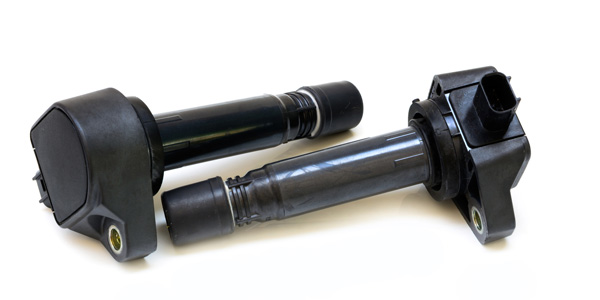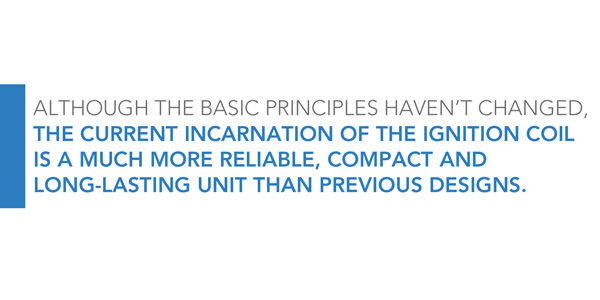
Today, the term “tuneup” still gets tossed around, even though the components that made up this traditional service staple are mostly obsolete. With the industry move to distributorless ignition systems, once-common items such as points, condensers, caps, rotors and even ignition wires are less frequent sales than they were even 10 years ago. Aside from the ever-present spark plug, the last remnant of the traditional ignition system is the coil.
Although the basic principles of induction and electromagnetism haven’t changed in the 100-plus years since its introduction, the current incarnation of the ignition coil is a much more reliable, compact and long-lasting unit than those used in previous designs.
Modern ignition coils still come in a few different styles, but the most popular by far is the coil-on-plug (COP) coil. In this design, each cylinder gets its own coil, eliminating the need for an ignition wire, but their compact size makes them somewhat more delicate and of course, as cylinders multiply, so do the coils. Having more coils divides the work and the stress on each coil, resulting in better and more consistent spark at each cylinder. It also makes individual coil failures easily traceable through individual cylinder misfire codes. Unlike single-coil distributor ignitions, these multiple-coil designs allow the technician to troubleshoot and replace individual units quickly, and isolates low-voltage fouling and misfires to only the cylinder with the affected coil.
The coil-near-plug (CNP) design also features individual coils for each cylinder, but they’re connected to their spark plug by a short ignition wire. This design allows for flexibility in coil positioning and cylinder-head design, and is seen primarily on pushrod-style valve trains. Still other applications use a hybrid of these two designs. In this kind of dual-spark system, each coil feeds two cylinders – one as a COP, and the second via an ignition wire.

Multiple-cylinder coil “packs” still are a common sale, feeding two or more cylinders per coil. Partial failure of the coil pack may only affect one of two cylinders, but it still requires replacement of the entire unit. Other dual-spark coil designs, like those found on the Dodge/RAM 5.7L, feed two spark plugs within the same cylinder. (2003-2005 designs use a boot-and-wire design; 2006-later designs feature twin-coil boots.) The 1990s-era Ford 2.3L dual-plug design, however, used two separate coil packs and eight plug wires to feed the intake and exhaust spark plugs for this quirky little four-cylinder engine.
Technicians still like to swap individual coils between cylinders as a “shotgun”coil-testing method, but be aware that some manufacturers use different coil designs between cylinders. Often, these are catalogued by position (left or right, front or rear), or by cylinder-bank designation, and are not interchangeable.
Even though modern ignition coils aren’t an automatic “tuneup” sale, the boots and wiring associated with them can become “collateral damage” when replacing spark plugs. Removing a COP coil to remove the spark plug can damage the coil’s electrical connector or the coil boot, resulting in add-on sales. In addition, some engines require removal of the upper intake plenum to gain access to the plugs at all. Gaskets, O-rings and seals for these applications often are forgotten during the initial order for plugs or coils, so suggesting these add-ons can save your customer downtime, save you additional delivery expenses and increase your invoice totals.








